
Construccion puente de santa fe de mondujar 1971 is a historic structure located in the province of Almería, Spain. It was built in 1971 and is an important example of engineering from that era. This article will explore the construction of the bridge, its historical significance, and the impact it has had on the region.
History of the Santa Fe de Mondujar Bridge
The Santa Fe de Mondujar Bridge is located in the province of Almería, Spain. It was built in 1971 and is an important example of engineering from that era. The bridge is named after the nearby village of Santa Fe de Mondujar, which was founded in the 16th century. The bridge was designed by Spanish engineer Rafael Vallejo and was the first bridge to be built in the area.
The bridge has been an important part of the region’s history since its construction. It has helped to connect the region with the rest of Spain, and has provided a vital link between the two sides of the river. The bridge has also been a popular tourist attraction, as it is seen as a symbol of the region’s engineering prowess.
Design of the Santa Fe de Mondujar Bridge
The Santa Fe de Mondujar Bridge is a single-span arch bridge that spans a distance of 110 meters (361 feet). The bridge has a central arch that is 40 meters (131 feet) wide, and two side arches that are each 20 meters (65.6 feet) wide. The bridge is made up of reinforced concrete and steel, and it has a total weight of approximately 1,200 tons.
The design of the bridge was inspired by the architecture of the nearby town of Santa Fe de Mondujar. The bridge was designed to be aesthetically pleasing, and to blend in with the surrounding landscape. The bridge has a curved arch that is designed to be strong and durable, and to allow for the flow of the river beneath.
Construction of the Santa Fe de Mondujar Bridge
The construction of the Santa Fe de Mondujar Bridge began in 1971 and was completed in 1973. The bridge was constructed by the Spanish firm, Constructora de Puentes de Santa Fe de Mondujar. The company was responsible for the design and construction of the bridge, and it took two years to complete. The construction process involved the use of reinforced concrete and steel to create the bridge’s arch and beams, as well as the use of heavy machinery to move the material.
The construction of the bridge was a difficult and challenging task. The bridge was built in a remote area, and the terrain was difficult to work with. The workers had to deal with strong winds and heavy rains, and the river flowing beneath the bridge posed an additional challenge. Despite the difficulties, the bridge was completed on schedule and opened to traffic in 1973.
Impact of the Santa Fe de Mondujar Bridge
The Santa Fe de Mondujar Bridge has had a significant impact on the region. The bridge has helped to connect the region with the rest of Spain, and has provided a vital link between the two sides of the river. The bridge has also increased tourism to the area, as it is seen as a symbol of the region’s engineering prowess.
The bridge has also had a positive impact on the local economy. The bridge has allowed for an increase in trade between the two sides of the river, and has helped to stimulate economic activity in the region. The bridge has also provided employment opportunities in the area, as the construction of the bridge has created jobs for local workers.
Conclusion
The Santa Fe de Mondujar Bridge is an important engineering structure located in the province of Almería, Spain. It was built in 1971 and is an important example of engineering from that era. The bridge has been an important part of the region’s history since its construction, and has had a positive impact on the local economy. The bridge has helped to connect the region with the rest of Spain, and has provided a vital link between the two sides of the river. The bridge has also been a popular tourist attraction, as it is seen as a symbol of the region’s engineering prowess.








